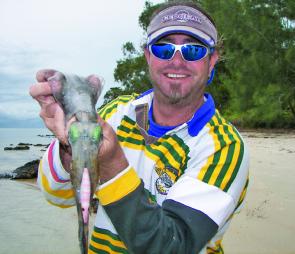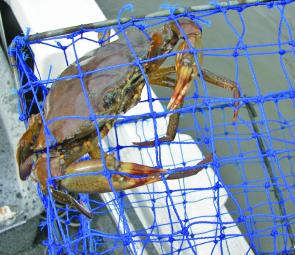February looks like it will be a cracker month for the southeast’s anglers. Recent rains have flushed our local creeks and estuaries, which should fire up the fishing, prawning and crabbing.
Sand crabs are around in reasonable numbers at the mouth of the river, the mouths of both Boggy and Bulimba creeks, the Boat Passage, along both sides of the river around Pinkenba, and around the Gateway Bridge on the golf course side. Fresh baits, early morning starts and being prepared to move your dillies or pots around will produce good numbers of crabs. Try crabbing in different depths from shallow flats to the deepest holes. I’ve found the latter to be the best, especially on a run-out tide.
Over the years of crabbing the river, I’ve found that structure is the key to targeting muddies. Mangrove lined gut-ways, jetties and deep rock walls are the areas to target when placing your pots. Like sandies, fresh bait and continual moving of your traps is essential to locate good numbers of crabs.
Generally once the crabs are located, I’ll move all my traps into that general vicinity to maximise our chances of results.
Prawns have been showing up in reasonable early season numbers, which is a good sign. The traditional prawning season starts in late February and continues throughout March. The river has a semi reliable consistency of prawns year round if you’re prepared to put the time and look for them. Most of the reliable prawning areas in the river have been closed due to the ‘exclusion zones’ but you can still catch good numbers along the banks, around deep holes and in between jetties. It’s a good tip to watch where the river trawlers are working and target that general vicinity closer into the bank where they cannot trawl. Later in the month prawns will start to congregate onto the flats at the mouth of the river and into Bramble Bay. Look for the concentrations of boats to find the prawns.
Snapper, jew and the odd threadfin salmon are being caught around the mouth of the river on live baits and artificials. The same three species are also being regularly caught around the mouth of Breakfast Creek. This is a great area for both land-based and boat fishing. Good numbers of smaller snapper are being caught along the Hamilton stretch of the river on soft plastics. The current really thumps through this area and it fishes best on the top or bottom of the tides or when there is very little run.
Vibration style lures definitely find concentrations of fish in the river, yet I always seem to catch my bigger fish on soft plastics, probably due the lighter presentation. I’ve been using the ‘new’ Ecogear BTS (big tail shad), a soft plastic that really works well for snapper and almost everything that lives in the river.
Summer and the more common winter whiting are being caught in good numbers on the sand flats at the mouth of the river and adjoining weed banks. Dead baits like peeled prawns and squid strips will produce good numbers of fish but nothing beats live bait. Fresh live baits like worms and yabbies collected locally will produce good numbers and better quality whiting in February.
Mackerel have put in a welcome appearance throughout the bay. Start looking for surface action from the mouth of the river and around the smaller bay islands (Green, St Helena and Mud). If surface feeding fish cannot be located in this area then try ‘beacon bashing’ the shipping pylons that lead out of the river with baits or high speed jigging with chrome slugs.
The reclaimed section at the mouth and rock walls around Pinkenba are worth a try for large bream and school size flathead. Unweighted yabbies fished amongst the rocks will produce excellent numbers of quality bream, while fresh strip baits and small live baits will land flathead. Good quality bream are being caught in the shallows around Mud, St Helena and Green islands on small hard body lures like SX40s and CK40FO7s from the Ecogear stable.
Squid are around in good numbers and they can be caught all year round. I chase squid in very shallow water where they can be sight fished. I like targeting squid in rocky, weedy areas that have good tidal flow. If bait are scattered on the surface – it’s the perfect place to try. Squid will move from day to day, tide to tide depending on the food source. I’ve fished areas on consecutive days with excellent catches one day; the same conditions the next day and a desert. Why? No bait, so we usually move to the next island or rocky outcrop (weather dependant) where the bait is showing and squid will start to follow and take jigs.
Squid can also be found around jetties and boat ramps at night. They chase baitfish that are attracted to the lights on the water. This type of squidding is heaps of fun and can be enjoyed by the whole family. When fishing from jetties and boat ramps, try placing a ‘glow-stick’ about 40-60cm in front of your jig to add an extra attractant.
If you would like some arm burning, heavy weight action then get some big live baits and hit the shipping beacons for some big estuary cod action. There are still plenty of unstoppable cod hanging around theses beacons. Remember to release the larger fish because they taste like… well you know, and they are generally older than the person catching it.
Reads: 3638
This squid was taken on an Ecogear jig near Dunwich, Stradbroke Island, and new years day.

Mud crabs are around at the moment.

Colin with a nice size summer whiting caught on the new Ecogear 40mm Vibration bait.




